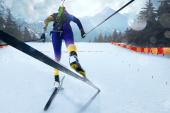Climbing Everest? Cardiac Arrhythmias Join Other Fabled Risks
Bradyarrhythmias were the most common, but two climbers developed ventricular tachyarrhythmias at altitude.

Avalanche, hypothermia, and falling ice are among the storied risks of attempting a summit of the world’s highest mountain, but new research has uncovered another: more than one-third of experienced climbers going up Mount Everest during a recent season developed cardiac arrhythmias, mostly bradyarrhythmias.
The proportion of arrhythmias was relatively stable as the altitudes increased, but event rates did increase between 5,300 m and 7,300 m before declining at higher altitudes when supplemental oxygen was used, a new study shows.
Arterial hypoxemia, along with electrolyte imbalances and periodic breathing, can contribute to the risk of cardiac arrhythmias at such great heights. Pilgrim said the development of cardiac arrhythmias has been seen in prior studies conducted at lower altitude.
“Most studies went maybe to 5,000 or 6,000 meters, but there was no evidence at extreme altitude,” he said. “The available evidence was also a little bit limited by the small number of participants. Our study is also limited because we don't have 200 participants, [for example], but if you consider the total number of licenses to climb Mount Everest, it’s still a respectable number.”
In total, Pilgrim, along with first author Kunjang Sherpa, MD (National Academy of Medical Sciences, Kathmandu, Nepal), recruited 41 climbers (mean age 33.6 years; 100% male) to participate in the SUMMIT study, published this week in JAMA Cardiology. Baseline testing 12 weeks out was performed using 12-lead electrocardiography, transthoracic echocardiography, or exercise stress testing in all climbers and showed no signs of exertional ischemia or wall motion abnormalities. Additionally, ambulatory rhythm monitoring was done at baseline in 35 participants and no supraventricular or ventricular arrhythmias were detected. For the climb, ambulatory rhythm recording was captured with a continuous ECG patch (ATsens).
Among the 34 participants with complete data, 32 reached 7,900 m or higher, 23 reached more than 8,500 m, and 14 made it to the top of Mount Everest. Supplemental oxygen was used by 94.1% of climbers beyond 6,500 m.
Thirteen climbers (38.2%) developed 43 bradyarrhythmic events while two tachyarrhythmias (5.9%) were recorded in two climbers, both at altitudes of 6,500 m or higher. There were no ventricular arrhythmias recorded from Camp 4 to the summit (7,900 to 8,849 m). The percentage of climbers with any arrhythmia was stable across increasing altitudes, but the number of events increased from 0.16 to 0.37 per 24 hours between 5,300 and 7,300 m.
The baseline characteristics of those who developed cardiac arrhythmias did not differ from those who didn’t, report investigators. All climbers were free from dizziness, palpitations, and chest pain.
Different Pathophysiologic Mechanisms
Pilgrim, whose own push to the summit was halted at the South Col due to bad weather, said there are several pathophysiological mechanisms that may explain the development of arrhythmias. The autonomic nervous system, he explained, is believed to play a role in the onset of bradyarrhythmias in a high-altitude, hypoxic environment.
“You have this periodic breathing pattern that is characteristic at high altitude and under these conditions you develop a sort of autonomic conflict that induces bradyarrhythmia,” he said, referring to the interplay of the parasympathetic and sympathetic pathways. In fact, the periodic breathing at high altitude has mechanistic similarities to the periodic breathing in those with sleep apnea, a condition that is also associated with the incidence of bradyarrhythmias.
The onset of tachyarrhythmia, on the other hand, is possibly related to electrolyte imbalances that result from hyperventilation, which in turn can affect cardiac repolarization and QT-interval prolongation. Fortunately, he said, these events were infrequent.
In terms of next steps, Pilgrim said they would like to identify individuals who may be at risk for developing arrhythmias and to determine if there is a correlation between these arrhythmias and clinical events.
“When you think about altitude, you have so many people dying and you don't really know at the end of the day, if it's not an accident, what happened,” he said. “Well, maybe they had a cardiac event and maybe they had a certain risk. For example, I think if you maybe have QT prolongation at baseline, well, maybe it's not such a good idea to climb to extreme altitude because then you are at even higher risk of tachyarrhythmia.”
Pilgrim noted that the study included experienced climbers mostly made up of those from the Nepali Sherpa or non-Sherpa community. In the past, Pilgrim has collaborated with Kunjang Sherpa to screen Nepalese children for rheumatic heart disease and that collaboration allowed researchers to gain access to the Sherpa climbing community, all of whom were eager to participate in this study, he said.
Michael O’Riordan is the Managing Editor for TCTMD. He completed his undergraduate degrees at Queen’s University in Kingston, ON, and…
Read Full BioSources
Sherpa K, Phurba Sherpa P, Sherpa T, et al. Risk of cardiac arrhythmia among climbers on Mount Everest. JAMA Cardiol. 2024;Epub ahead of print.
Disclosures
- Pilgrim reports research, travel, or educational grants to their institution without personal remuneration from Biotronik, Boston Scientific, Edwards Lifesciences, and ATsens, and speaker fees and consultancy fees to their institution from Biotronik, Boston Scientific, Edwards Lifesciences, Abbott, Medtronic, Biosensors, and HighLife outside the submitted work.






Comments